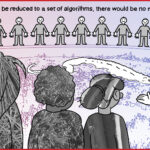Mismanagement by DoHAC is stymieing engagement with GPs. That they’re pushing a certain mental health app is a red flag.
I sort of suspected this might happen, but on attending my first actual PHN conference a few weeks back – surprised to be allowed to show my face at such a gathering – what I found was an enthusiastic room full of smart people sharing good ideas and wanting desperately to move the dial on integrated community care.
I say I suspected this might be the case because until I decided to shirtfront a few of the people actually running PHNs, from the outside looking in, it was pretty easy to look at things and find fault.
The governance of PHNs, for instance, has always seemed all over the place.
Their annual reports all share auditors who use the same process and language to project an air of organisation and calm, but each PHN has a complex and different origin story, unique cultural elements associated with its evolution based on personalities and the demographics of the region it serves, and of course, local and national politics.
What you see from the outside is that between one PHN and the next, performance seems to vary wildly for what they are supposed to be doing: providing the glue that binds various community based services, including general practice, to create far better continuity of care for patients in the community.
What you also often see is a level of disconnection from what should be key community-based resources that you’d think would be priorities for engagement.
The most important and overt example is probably GP networks.
Why do a lot of GPs not engage much with PHNs and sometimes feel that PHNs are working more against them than with them?
Even in some of the best run PHNs, leadership will say 30% of their local GPs are well engaged with them, 30% are engaged off and on, and the rest simply don’t engage. And that’s self-reporting.
The PHN conference left me with a fair dose of cognitive dissonance on how I had been thinking about these organisations.
How is that all these good people, ideas, enthusiasm, commitment and smarts do not seem to be translating better in the real world?
I imagine from the inside looking out, a lot of PHNs feel or even see that their work is translating really well, so here is an example of someone looking from the outside in feeling that this is not always the case.
A sizeable portion (often the biggest single element) of each yearly PHN funding envelope is spent on the mother of all healthcare brick walls, community mental health programs.
It means that over half of yearly PHN funding (more than $600m) is concentrated into mental health.
A key issue, surely, is that nearly all of this funding is spent outside of GP networks.
It’s an issue because GP networks are without question the backbone of community mental health management across the country.
Why wouldn’t this funding be highly integrated with an existing – stressed but nonetheless highly effective – community asset, general practice?
It doesn’t make much sense and from the outside looking in your natural tendency is to blame the PHNs for not directing their funding properly.
This is surely one key underlying reason why a lot of GPs have become so sceptical about PHNs and their role.
What’s worse is that a lot of PHNs have decided to follow a path of community mental health management based on the increasingly controversial evidence for widespread use of digital mental health platforms.
Head to Health is a key program that many PHNs have been directed to provide by their masters at DoHAC.
On spec Head to Health sounds great.
Here is how one Sydney PHN describes its version of the program:
Head to Health offers a safe and welcoming place for people to access mental health information, services and supports from multidisciplinary care teams over extended hours. Anyone can reach out for support for themselves or a loved one.
And here is how the program is described in a recent release from DoHAC:
Head to Health services offer short to medium-term care for people with moderate to severe mental health needs, and immediate support and follow-up can be provided to people presenting in crisis.
Head to Health services will simplify access to mental health advice and support making quality information and care more accessible for people.
Who could fault such an initiative?
This whole initiative is directed from DoHAC through the PHNs without any meaningful attempt at integration to or communication with our most important and effective existing community mental health management asset, local GP networks.
In other words, PHNs aren’t engaging because DoHAC is not funding them to engage with GPs in this vital area.
We know from BEACH (but can’t get any updated information, unfortunately) that upwards of 15% of GP consultations are directly related to mental health and a significant percentage of other consultations have a mental health element to them.
We also know that GPs see the most unwell, vulnerable, and marginalised people in the system and these people’s mental health issues are complex and largely do not fit the model of care offered by digital mental health platforms.
Context is vital in complex mental health management so if you are the person providing broader care, you have much better information to help with mental health management.
As far as GP networks go Head to Health is virtually a standalone service focused on mild-to-moderate first-episode single-disorder management using mental health digital platforms and call centres as a key strategy to achieve scale.
The evidence is still very poor for the efficacy of mental health platforms used this way (indeed used in any way) and we know that first-episode single-disorder patients make up a very low proportion of the mental health population in need.
But put aside any controversy over the approach or its evidence base.
Why would you run any of these programs in what looks like a deliberate separation from what is being done within GP networks?
Here is just one story which illustrates how potentially out of kilter this whole situation has become and the danger of not engaging with GP networks in this work.
In the past year, a major PHN commissioning for a local mental health program and in a negotiation with a local branch of headspace told the branch that it would only be considered for the contract on offer if it adopted and used the controversial mental health platform Innowell for the contract.
Where do you start on how badly wrong this approach could go for everyone involved?
Innowell is a commercial platform owned substantively by the consulting firm PwC and Sydney University but also part-owned by past national mental health commissioner and often controversial figure Professor Ian Hickie.
PwC has pushed the platform on its own website to its own clients via their partners who consult on mental health programs without declaring it has a major commercial stake in the product.
Under the circumstances, a PHN on-selling a commercial product in this manner is surely a red flag.
Like most of the mental health apps hitting the market, there is so far no proper evidence base that supports the efficacy of the Innowell app as spruiked by the owners.
In fact, in the only formal public assessment of the platform a University of NSW academic review group found that there were so many issues with implementing the app in the various community trials that there simply were never enough users who stayed with the app long enough to be able to determine efficacy.
If this is true then why is a PHN out there insisting a potential provider must buy the Innowell app to use or else they won’t be considered for a multi-million-dollar contract?
Putting such a condition around the awarding of such a contract feels like it might be even illegal, as it suggests some sort of commercial relationship and incentive on the part of this PHN to on-sell Innowell.
How did a PHN get so far into spending so much public money on what is clearly still the unknown wilderness and bleeding edge of community mental health service provision?
Why is a PHN pushing a mental health app as a key community solution when debate is raging over whether any of these apps address the needs of the most dispossessed in terms of mental health in our community, and who largely, are seeing GPs for help because their help requires far more complex management than an app?
There aren’t any easy answers to these questions but there’s certainly what looks like a smoking gun in this example.
Firstly, PHNs aren’t engaging with GPs in mental health properly because they are being directed not to by DoHAC.
In this particular example of going a long way off the rails, the fact that a PHN ended up pushing a particular digital mental health platform owned privately (in large part) by a major and now discredited consulting firm feels like it could have something to do with the following:
- Innowell was started with a $30m non-competitive grant awarded to PwC and Sydney University by DoHAC around 2017
- Innowell became politically embarrassing for DoHAC (and probably several government ministers) after most of the money had been spent and an academic review of the platform in 2019 found no evidence for it working.
- PwC ended up writing DoHAC’s digital mental health strategy. In that strategy Innowell gets a mention as an example of the sort of platforms that are needed but nowhere does DoHAC or PwC declare that PwC owns Innowell.
Innowell is highly political.
A lot of reputations and egos in Canberra are still tied up in it one day being a success.
Essentially its original grant was directed from the prime minister’s office based on several senior figures in mental health policy and development personally lobbying the prime minster of the time and running a narrative through the mainstream media on the massive potential for digital mental health platforms.
Innowell hasn’t worked. Its owners still argue it does and point to it being commercially viable, but to date there is no credible peer-reviewed research that has proven its efficacy.
It’s been nearly six years now without that evidence, but it’s still out there being on-sold by government-funded entities as part of a highly directive mental health program which is being run out of DoHAC, whose digital health strategy was written by the owners of the platform.
That DoHAC is being so controlling about what PHNs do in terms of mental health is the simple answer to all the questions I have asked above about what is going on with PHNs and why they don’t engage properly with the key community-based healthcare providers like GPs.
For some reason DoHAC has never understood its own creation – PHNs – and what they are supposed to be doing, as outlined pretty clearly in the original government review that recommended their creation.
PHNs are regional groups that are supposed to use their local knowledge to do research on their local populations’ health needs, establish the key determinants of those needs, then go about commissioning services to meet those needs, monitor delivery efficacy over time and adapt if things are wrong.
What a fantastic concept.
If PHNs actually worked this way, they would likely be kicking a lot more goals in terms of pivoting our system to better focus and efficiency in community care and they certainly wouldn’t be alienated to some degree from their key constituent community healthcare providers.
Likely, staff at PHNs would be a lot more fulfilled as well.
But PHNs don’t work that way.
PHNs are largely busy executing what each of the reasonably siloed elements of DoHAC – aged care, Indigenous health, general practice, mental health, PHNs, alcohol and drugs et al. – are asking them to do, according to their own ideas of what is needed in the community for their divisions.
The whole PHN system is badly upside down.
It is being directed to respond to the centrally generated ideas (whims?) of DoHAC divisions rather than doing proper regional population based research as the first step of the process and pointing DoHAC to the actual problems that exist, based on this research, and then working with DoHAC to create funding so they can commission services appropriate to solve those problems efficiently.
If you think this is an inefficient and flawed way to go about things, then add to the above:
- PHNs are still required to do population analysis but this is often largely to back engineer logic for directives on programs they already have or necessarily align to the short and mid-term objectives of DoHAC (witness how many PHNs pivoted to provide covid initiatives quickly during the pandemic – that was all directed out of DoHAC)
- Each division of DoHAC that directs a program to PHNs requires all those PHNs to report to them about their particular program on a regular basis, each division not really understanding what reporting burden the next one is requiring of the same PHN. One person described all these reports as lying in a “graveyard of data” somewhere inside DoHAC as there is so much information no one has time to read it.
- The turnover of the leadership of the division of DoHAC that runs PHNs has had a new leader about every year so for the past five-odd years, so the idea of continuity and learning is likely out the door.
There is another key element of DoHACs mismanagement of PHNs which is important to highlight here.
PHNs are not properly monitored or measured and provided with appropriate feedback based on such basic management and as a result PHNs that, for some reason are underperforming (there are lots), are not supported in any way to manage their way to better performance.
There are really high performing PHNs and really low performing ones. There is very little work being done to benchmark performance and share knowledge so the lower performing ones – usually ones with special regional and historical situations that put them at a disadvantage – have a path to improvement.
In this respect PHNs look a little like the far-flung fort outposts that the US government and army used to try to manage the frontiers and the American Indians in the mid-1800s.
The people manning those forts were isolated, underfunded, hardly ever part of the decision making in Washington, and had to risk their lives based on the ideas of people who were living a different life very far from the action. And of course the First Nations did not like the people in those forts.
DoHAC’s 2018 attempt at a program performance and quality framework (PPQF) for PHNs points to just how much the department didn’t understand what it was attempting to manage even back then.
The framework, like the management of the PHNs today by the department, is entirely directive and the measures of performance as largely just measures of activity – activity that DoHAC wants the PHNs to perform.
So if you do something DoHAC wants done, that’s a tick (as opposed to you do something that solves a patients problem in your community).
Critics have pointed out that outcomes and experiences of PHN clients are a more appropriate measure of performance.
The same critics have also pointed out that there has been a fundamental misunderstanding of what commissioning is in terms of PHN performance, and how it should work for PHNs.
In 2015 PwC – yep, them again – had a lot to do with creating the early definition of commissioning for PHNs in Australia where the focus was around it being a competitive tendering process designed to optimise provider contracts.
That narrow definition is now being challenged around the world.
One key local commentator recently outlined how much broader and more strategic commissioning is for optimising community care suggesting that all of the below points were key outcomes of the commissioning process along with the idea that it is about “purchasing”:
- Setting the strategic direction for the whole health system
- Designing services that meet local health needs
- Getting the balance right between competition and collaboration
- Building primary care capability and aligning services with identified needs
- Introducing new payment incentives such as outcomes-based payments
- Engaging meaningfully with clinicians and the community
- Supporting the development of key health enablers like digital health
When you look at those objectives and then at what most PHNs are being directed to do by DoHAC and measured on, the disconnect is pulpable.
The PPQF largely disappeared during covid and only in February this year did DoHAC publish a PHN program annual performance report.
The report published this year is for 2019-20, so we are three years behind.
If you read it, there is no proper method of measurement of PHN performance. The report is inward looking and focused around DoHAC objectives more than community care objectives (not that those two things don’t sometimes overlap).
Attempts to reference PHN performance back to lower hospital admissions are particularly outdated and have very weak evidence that PHNs actually did anything to create the results.
PHNs so far haven’t been measured for their ROI in any meaningful way by DoHAC.
You can’t manage what you don’t measure.
In 2021 PwC – they’re everywhere in this problem – published a DoHAC-commissioned PHN survey which reads like a PR brochure for how well PHNs are doing.
PHNs, in the scheme of what they could do if they were allowed to operate as they were originally envisioned to operate, are not performing well (someone might argue I don’t have evidence for such a statement, but in the absence of any data on performance at all, I’m making it).
But it’s not the fault of the PHNs.
So, maybe (I’m talking to myself here as well, remember), don’t be so down on PHNs.
They are trying but their hands are tied very tightly behind their backs in almost all respects of how they operate.
Maybe start rattling the cages of the some of the bureaucrats in DoHAC and Canberra to alert them to what they are doing wrong here.
PHNs – regional organisations tasked with researching community care needs over time and delivering services to meet those needs while optimising the existing network of care providers in that task – are a brilliant and essential idea which if managed correctly could help us transform care in the community over time.
We just need to let them do what they’re supposed to do.







